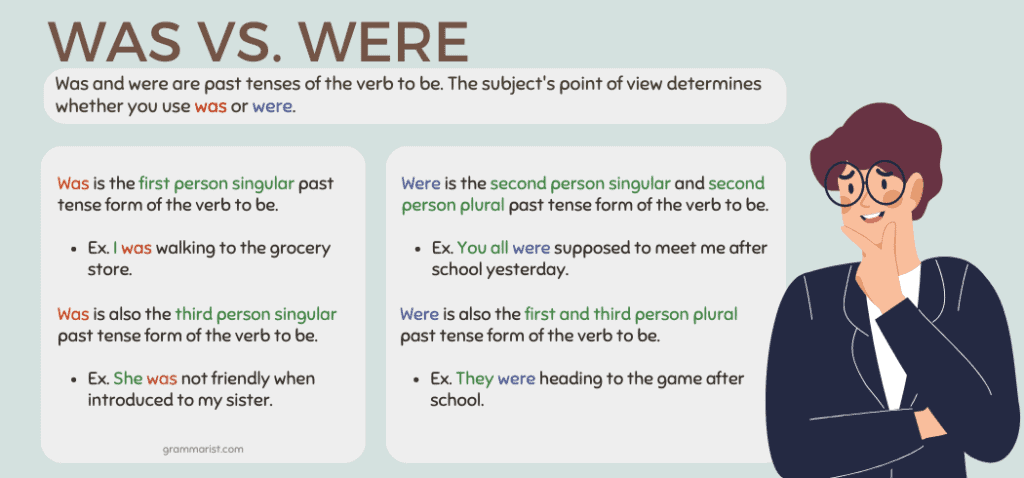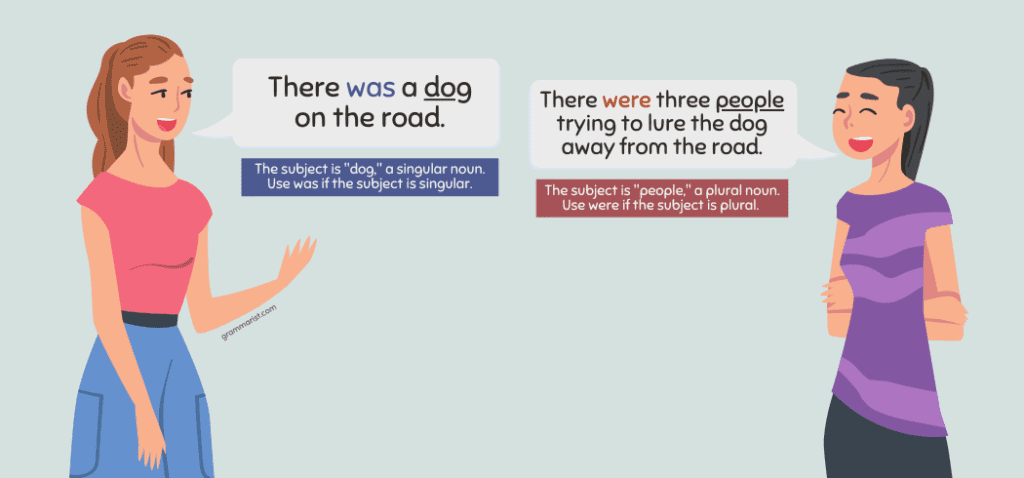If you sometimes struggle knowing when to use was and were, you aren’t alone. Many people are confused as to when to use the verb was and when to use the verb were. But the rules for using these terms are clear when you know what to look for.
Were and was are past tenses of the irregular verb to be. The verb to be is an irregular verb, which is a verb that does not follow any pattern or rules in its conjugation.
The verb to be is probably one of the most commonly used and confusing verbs in the English language. It can be particularly hard to understand whether to use were or was in certain situations if you don’t first determine the point of view the subject of the sentence provides.
What Is the Difference Between Was and Were?
Was and were are past tenses of the verb to be. The subject’s point of view determines whether you use was or were.
First Person Point of View: I, Me, My, Mine, Myself, We, Us, Our, Ours
Second Person Point of View: You, Your, Yours, Yourself
Third Person Point of View: He, Him, himself, She, Her, Hers, Herself, It, They, Them, Their, Theirs, Themselves
Was is the first person singular past tense form of the verb to be.
- I was walking to the grocery store.
Was is also the third person singular past tense form of the verb to be.
- She was not friendly when introduced to my sister.
Were is the second person singular and second person plural past tense form of the verb to be.
- You were heading in the wrong direction.
- You all were supposed to meet me after school yesterday.
Were is also the first and third person plural past tense form of the verb to be.
- We were going to the park when you drove by.
- They were heading to the game after school.
Be serves as an irregular verb and an irregular auxiliary verb. But what does being an irregular or irregular auxiliary verb have to do with it? First, let’s look at how to be is conjugated, so you understand how irregular verbs differ from other verbs.
Conjugating To Be
To be conjugates into five different forms:
Present
I am
You are
He/She/It is
We are
You are
They are
Past simple
I was
You were
He/She/It was
We were
You were
They were
What Is an Irregular Auxiliary Verb?
As you can see above, to be never used -ed in the past tense. Irregular verbs are defined as verbs that don’t use -ed in the past tense.
Irregular verbs rely on the auxiliary verb (or helping verb) to indicate the future, present, or past tense.
The past tense of to be can be used as a verb and as an auxiliary verb. When used as an auxiliary, it is followed by the verb to describe the tense.
For example:
- She was playing soccer.
- We were playing basketball.
It can also serve as a verb. For example,
- She was fifteen years old.
- They were high school graduates.
When to Use Was in a Sentence
Was is the first person singular past tense form of the verb to be and the third person singular past tense form of the verb to be.
For example:
- I was home last night.
- He was in bed at ten o’clock.
- She was at the restaurant until eleven.
- It was not a late night.
When to Use Were in a Sentence
Were is the second person singular and plural past tense form of the verb to be and the first and third person plural past tense form of the verb to be.
For example:
- We were going to the beach.
- You were home last night.
- The boys were in bed by ten o’clock.
- They were asleep by eleven.
There Were or There Was?
The use of were vs. was can get a little murky in a few situations. The first situation is when using the phrases there were or there was.
To use these terms correctly, you must identify the subject of the sentence and ensure the subject and verb are in agreement. Ensuring that a subject and verb are in agreement means making sure that they are either both plural or singular.
A good rule to remember is when a sentence begins with there, the subject is found after the verb. Once the subject has been identified, use the following rules:
- Use was if the subject is singular.
- Use were if the subject is plural.
Remember this rule when trying to decide whether to use was, were, or some other form of the verb to be.
For example:
- There was a dog on the road. (The subject is “dog,” a singular noun.)
- There were three people trying to lure the dog away from the road. (The subject is “people,” a plural noun.)
Hypothetical Situations
Using the word if or wish is a reliable indicator of using the subjective mood.
A subjunctive mood expresses a hypothetical situation that has not come to pass but might come to pass. It may be conditional, or it may simply be imaginary.
Subjunctive moods are almost always expressed using an if or I wish phrase.
A subjunctive mood always uses the past tense verb were. The verb were is the correct choice, regardless of whether the subject is singular or plural, when speaking of a conditional or hypothetical situation.
For example:
- If I were to ask her out, it’s possible she might tell me no.
- I wish I were there instead of sitting in class.
Using the word if is a reliable indicator of using subjective mood. Now you know that when faced with a choice between the phrases if I were or if I was, the phrase if I were is always correct.
Let’s Review
First Person Singular = Was
Third Person Singular = Was
Second Person Singular = Were
First Person Plural = Were
Second Person Plural = Were
Third Person Plural = Were
If the sentence is a hypothetical statement, always use were no matter whether the subject is singular or plural.

